





Rodents are one of the most common groups of wild animals one may encounter in the garden. This is a brief introduction to some of the North American rodents one might find in one's yard.
Most of our yards have their share of rodents, no matter how small the yard is or how urban it is. In some areas of the country, you might have several dozen species of rodents show up in your back yard while in others, about the only rodents you might come across are mice and rats. The following article is a cursory introduction to some of the more common American rodents and what, if anything, you should be concerned about should you find them in the yard.
When researching this article I was surprised to learn how many rodent species are native to North America, far more than I suspected, though I would guess most of them are ones we are not likely to come across in our yards. For example, not unless you live far out in the woods and have rivers on your property are you likely to run across beavers in your yard. And only those living in the barren deserts of the Southwest are likely to run across a kangaroo rat on a midnight stroll in their back yard. On the other hand, just about every yard in America has at least one visit by a Norway or Black Rat, or possibly a Fox Squirrel, or a common mouse. I will not be able to cover even close to all the rodents you might encounter, but I will try to briefly discuss the more common ones, along with a few slightly less common that I have come across myself.
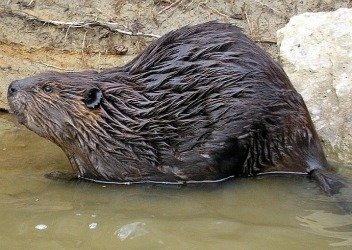
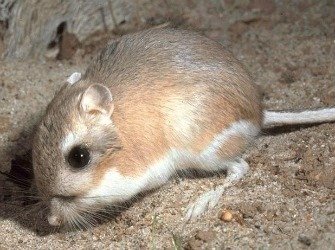
Beaver (photo Wikipedia) Kangaroo Rat (photo Wikipedia)
Probably the most visible rodents you encounter in your back yards are the common squirrel species. In most areas of the US, these would include the tree squirrels, of which the Fox, Red and various Gray Squirrels are the most common. You might also encounter a variety of ground squirrels, of which there are nearly twenty different species. Both tree and ground squirrels can be quite destructive, but the tree squirrels are often also very entertaining and are considered by most, much "cuter" and worth rescuing if you find an orphaned or injured individual.
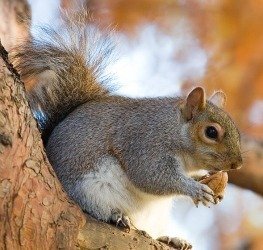
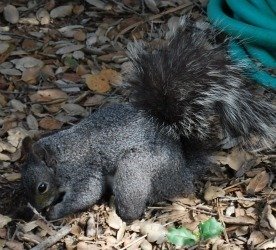
Eastern Gray Squirrel (Wikipedia) Western Gray Squirrel
Though not a native to the western U.S, fox squirrels have invaded everywhere and are easily the best squirrel at competing and adapting to living among us humans. These squirrels are very aggressive, active, prolific eaters and breeders and just about everyone has either fed one or chased one off at some point in their lives. Though not nearly as big a pest as some other rodent species, these animals can eat crops, injure plants, dig up pots and spread seed from other yards into yours. But the worst damage these rodents do is to your home, insulation, wires and other related structures. I find it is best not to encourage these species from living around your house and yard, though making sure your house itself is squirrel proof should be your main concern. For more on how to keep squirrels from your house, see this link from the University of Nebraska.
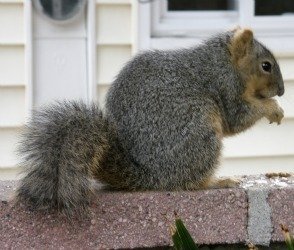
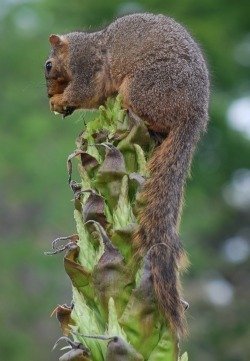
Fox Squirrel in my yard (left) and destroying a Puya flower (right)
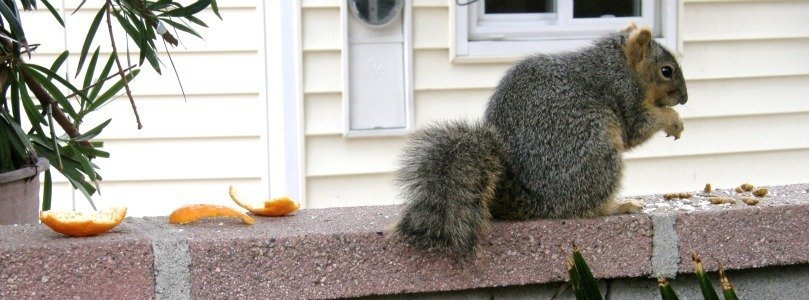
Neighbor attracting squirrels to our mutual brick wall by offering it oranges and cat food. This is not really the sort of behavior I want to encourage
Ground squirrels, in my opinion, are much more serious threats to your yard and its plants. Though perhaps not on par with gophers in the destructive category, ground squirrels can cause a lot of underground havoc and eat a lot of plant material, both above and below ground. These animals can create large, complex burrow systems that undermine structures, patios and sidewalks and create dangerous sink holes you can injure your ankle falling into, or can be serious problems if you have horses. Additionally, they are prolific fruit and nut eaters as well as feeding on most other forms of vegetation. And lastly, these are, for some reason, major carriers of fleas and ticks that can spread to your pets. There are few pluses to having these rodents around, and if found in the yard, the sooner one moves to get rid of them, the better. See this link for more on controlling ground squirrels.
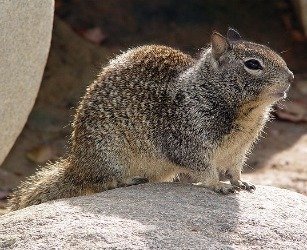
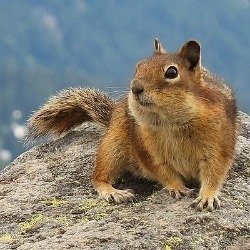
California Ground Squirrel (one of my worst garden nemesis) left; right Golden Mantle Ground Squirrel (both photos Wikipedia)
Chipmunks are pretty closely related to ground squirrels, but these tend to be smaller and less destructive creatures, and rarely a significant danger to you or your garden. And they are really cute (or so most think so). One thing I didn't know was that chipmunks not only eat plants and grain, but harmful bugs, slugs and snails as well, so they can actually be a garden friend as well as a possible pest. They do tend to move into homes, chew wires, and make messes in ones' house, however. For information on chipmunk control, you can try this link to United Wildlife.
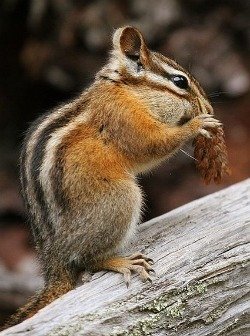 Chipmunk (photo Wikipedia)
Chipmunk (photo Wikipedia)
Pocket Gophers (often referred to as just gophers) are probably the most destructive, though less visible, of all the back yard rodents. Gophers are nearly always underground and you can lose a good portion of your favorite plants to gophers and still never glimpse one. These relatively small rodents have huge teeth and seem to eat ten times their weight in expensive ornamental plants, vegetables and fruit trees. I have struggled for years with gopher control and it has been a frustrating experience. I cannot even begin to count all the plants I have lost to these pesky rodents. They have devoured nearly entire banana trees and they eat just about anything, even many so-called toxic plants. Also, their tunnels are a nuisance and can cause erosion problems and can be similarly dangerous to step into for people, dogs and horses, though not quite as deep or large as ground squirrel burrows. There are many articles written on how to control these pests, but nothing is fool proof with these creatures and seeking professional help might be recommended. Note that if one has dogs, I strongly recommend avoid any of the poison techniques as all rodent poisons are nearly equally toxic to dogs and cats as they are to rodents, and as an emergency veterinary clinician, I see an awful lot of poisoned dogs from rodent baits (many end up being fatal, too). Also another note, I have had moderately good success using road flares in gopher tunnels despite the reservations about their effectiveness in many of the internet articles you may come across. You might give them a try. Here is more on gopher control at bugspray.com and University of California Davis.
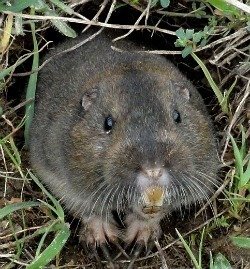
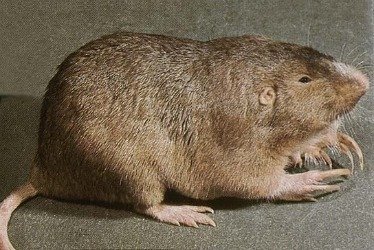
Pocket Gopher photos from Wikipedia (not excactly the cutest back yard rodents)
There are just under fifty species of mice (and 75 if you include the voles, which are pretty much just stockier mice with shorter tails) and over 30 species of rats in the U.S., though most of these are not common nor would you consider many of them pests. Some are adorable and very non-pest-like species (the kangaroo rats, for example). But most are not really what you would want to find in your back yard. Mice are primarily a problem if they get into and begin to live in your house, but most strictly yard mice are not that destructive. Still if they are in your yard, your house will look like a paradise to them, so you should probably not encourage their continued existence in the yard. Mice can carry other pests like fleas and even dangerous viruses. They can do damage to crops in their own small ways. For more on mouse control see this YouTube video.
A reader of this article pointed out to me, rightly so, that though voles and mice may be about the same size, the vole is a much more damaging yard invader and some have compared these to gophers on amphetamines. They tend to live in gopher-like tunnels, but in larger colonies and do very similar damage to plants and trees, living primarily on roots. And similar to gophers, vole burrows make hazardous walking about the yard by both people and horses. For more on voles, their destructive behavior and removal suggestions, see this link: http://www.unitedwildlife.com/AnimalsVoles.html
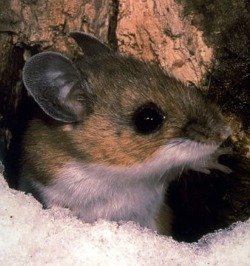
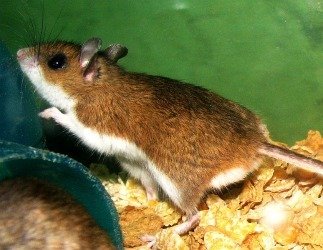
Deer Mice photos from Wikipedia... this is one of the primary vectors of the deadly Hanta Virus
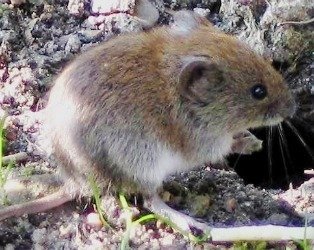 Vole photo from Wikipedia (looks like a mouse to me)
Vole photo from Wikipedia (looks like a mouse to me)
Rats are more of concern than mice in terms of spread of disease and damage to property (often due to their sheer numbers and incredibly rapid reproduction). Again, mice and rat baits, though very effective, are also very effective and killing your pet dogs and cats. So if you have pets, do NOT use these products. It is just not worth the risk. For more on rat control, see this link. One of the reasons I had such a serious rat infestation once was I had chickens, and chicken feed is very attractive to rats. It is nearly impossible to have chickens and not to have rats, too. So if you want no rats, probably best to have no chickens, either.
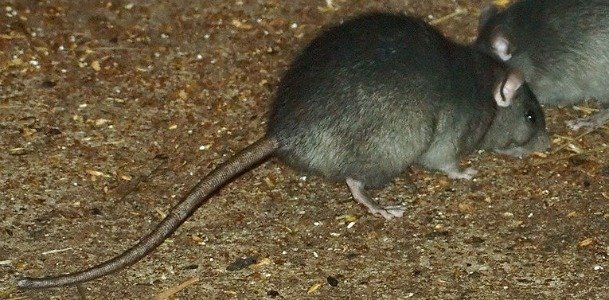
Black Rat (one of the most common rats in urban areas throughout the US
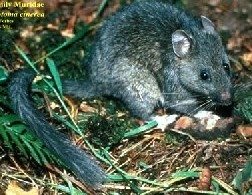 Packrat or Wood Rat- a less fearful and less destructive creature (photo Wikipedia)
Packrat or Wood Rat- a less fearful and less destructive creature (photo Wikipedia)
I lived in New Mexico for a while and there I encountered a few less common but interesting rodents, sometimes in our back yard. Porcupines, one of the largest of the American rodents, may occasionally end up in a back yard, particularly if you live near a forested area, which we did. Though pretty shy and unintrusive, these spiny rodents can do some serious damage to tree bark, often to the point of killing the tree, as well as gnawing destructively on manmade structures. But their main pest concern is from being attacked by the family dog, which then invariably ends up with their face and mouth full of spines that need to be surgically extracted. I have spent many hours at work doing just that and I felt very sad for those poor (but possibly deserving?) dogs. Ouch!
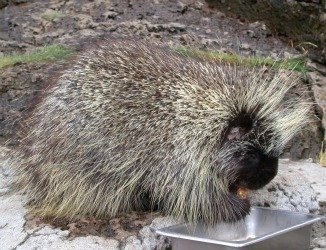
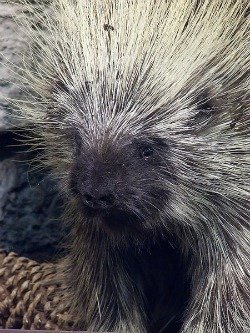
Porcupine eating some food offered it (left); right is head shot from Wikipedia
Another rodent we found in in New Mexico was the Prairie Dog. These are the equivalent of a giant ground squirrels, and their burrows and mounds can be immense in comparison (called towns they are so large). So too can their destructive potential. They also tend to be major flea carriers. They are fascinating and entertaining creatures, however, so they do have their upsides as well. Still, developing a nice plant collection or any sort of edible crop is a real challenge with a prairie dog town nearby. For information on Prairie Dog control from United Wildlife.
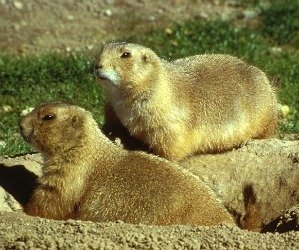 Prairie Dogs (photo Wikipedia)
Prairie Dogs (photo Wikipedia)
Though an extremely rare back yard rodent, my neighbor in California did have a Capybara run through his back yard a few years ago. At first he did not know what he was looking at and thought it was possibly the world's largest Guinea Pig (a related species, also a rodent). Capybaras are South American rodents and are the largest of all the world's rodents (about the size of a large dog). Though some used to be native to the very southern parts of the U.S., those species are now extinct. This particular animal was an escapee from someone's unlawfully imported collection and its capture in my friend's trash can made local news. It is not often one runs across a 100 pound rodent in your back yard! As far as I am aware, there are no links for Capybara control.
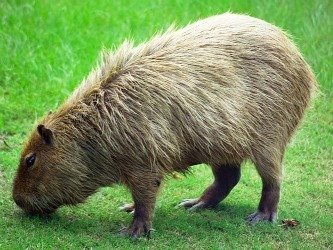 Capybara (photo Wikipedia)
Capybara (photo Wikipedia)
One may have wondered why I left out rabbits, moles and shrews in this article. It turns out, neither of these little creatures are rodents. Perhaps I will cover these in another article soon.
Other rodents that you might possibly encounter in your more "wilderness" back yards in the U.S. include:
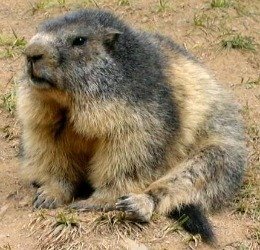
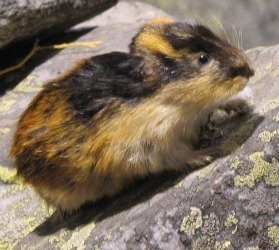
Marmots are fairly large rodents that tend to live at high altitudes in the forestier areas (left); Lemmings are from the very northern North Americas (photos Wikipedia)
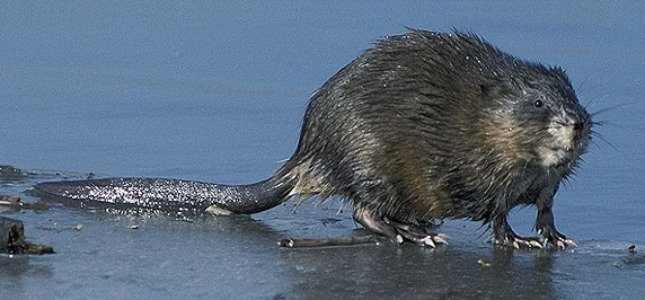
Muskrats live in along side streams and rivers, but could conceivably end up in someone's back yard (photo Wikipedia)
Copyright © www.100flowers.win Botanic Garden All Rights Reserved